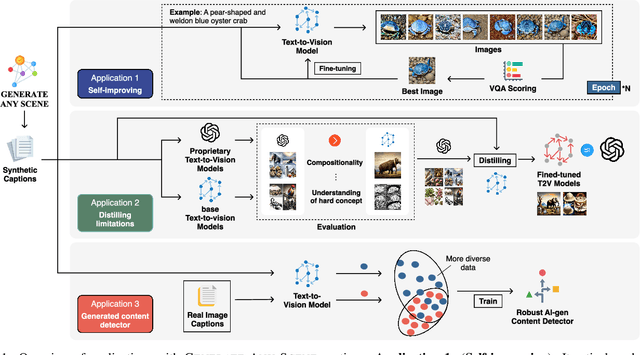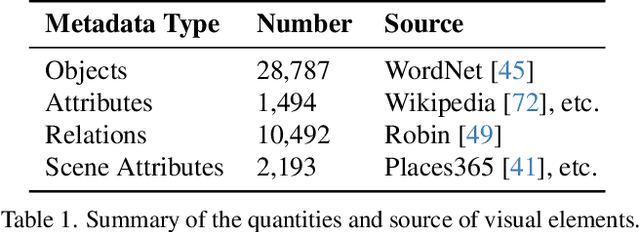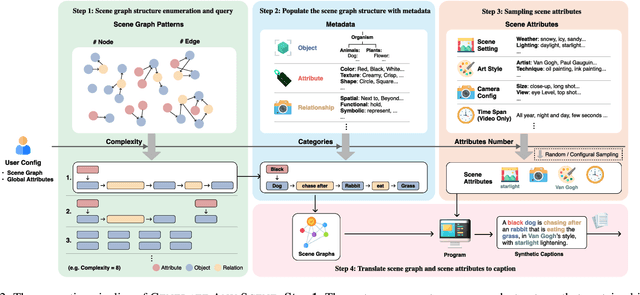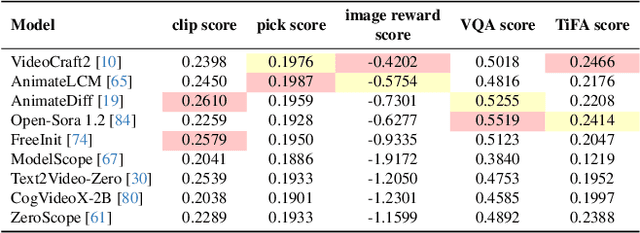Ziqi Gao
One Trajectory, One Token: Grounded Video Tokenization via Panoptic Sub-object Trajectory
May 29, 2025Abstract:Effective video tokenization is critical for scaling transformer models for long videos. Current approaches tokenize videos using space-time patches, leading to excessive tokens and computational inefficiencies. The best token reduction strategies degrade performance and barely reduce the number of tokens when the camera moves. We introduce grounded video tokenization, a paradigm that organizes tokens based on panoptic sub-object trajectories rather than fixed patches. Our method aligns with fundamental perceptual principles, ensuring that tokenization reflects scene complexity rather than video duration. We propose TrajViT, a video encoder that extracts object trajectories and converts them into semantically meaningful tokens, significantly reducing redundancy while maintaining temporal coherence. Trained with contrastive learning, TrajViT significantly outperforms space-time ViT (ViT3D) across multiple video understanding benchmarks, e.g., TrajViT outperforms ViT3D by a large margin of 6% top-5 recall in average at video-text retrieval task with 10x token deduction. We also show TrajViT as a stronger model than ViT3D for being the video encoder for modern VideoLLM, obtaining an average of 5.2% performance improvement across 6 VideoQA benchmarks while having 4x faster training time and 18x less inference FLOPs. TrajViT is the first efficient encoder to consistently outperform ViT3D across diverse video analysis tasks, making it a robust and scalable solution.
InversionGNN: A Dual Path Network for Multi-Property Molecular Optimization
Mar 03, 2025Abstract:Exploring chemical space to find novel molecules that simultaneously satisfy multiple properties is crucial in drug discovery. However, existing methods often struggle with trading off multiple properties due to the conflicting or correlated nature of chemical properties. To tackle this issue, we introduce InversionGNN framework, an effective yet sample-efficient dual-path graph neural network (GNN) for multi-objective drug discovery. In the direct prediction path of InversionGNN, we train the model for multi-property prediction to acquire knowledge of the optimal combination of functional groups. Then the learned chemical knowledge helps the inversion generation path to generate molecules with required properties. In order to decode the complex knowledge of multiple properties in the inversion path, we propose a gradient-based Pareto search method to balance conflicting properties and generate Pareto optimal molecules. Additionally, InversionGNN is able to search the full Pareto front approximately in discrete chemical space. Comprehensive experimental evaluations show that InversionGNN is both effective and sample-efficient in various discrete multi-objective settings including drug discovery.
Molecule Generation for Target Protein Binding with Hierarchical Consistency Diffusion Model
Mar 02, 2025Abstract:Effective generation of molecular structures, or new chemical entities, that bind to target proteins is crucial for lead identification and optimization in drug discovery. Despite advancements in atom- and motif-wise deep learning models for 3D molecular generation, current methods often struggle with validity and reliability. To address these issues, we develop the Atom-Motif Consistency Diffusion Model (AMDiff), utilizing a joint-training paradigm for multi-view learning. This model features a hierarchical diffusion architecture that integrates both atom- and motif-level views of molecules, allowing for comprehensive exploration of complementary information. By leveraging classifier-free guidance and incorporating binding site features as conditional inputs, AMDiff ensures robust molecule generation across diverse targets. Compared to existing approaches, AMDiff exhibits superior validity and novelty in generating molecules tailored to fit various protein pockets. Case studies targeting protein kinases, including Anaplastic Lymphoma Kinase (ALK) and Cyclin-dependent kinase 4 (CDK4), demonstrate the model's capability in structure-based de novo drug design. Overall, AMDiff bridges the gap between atom-view and motif-view drug discovery and speeds up the process of target-aware molecular generation.
Generate Any Scene: Evaluating and Improving Text-to-Vision Generation with Scene Graph Programming
Dec 11, 2024



Abstract:DALL-E and Sora have gained attention by producing implausible images, such as "astronauts riding a horse in space." Despite the proliferation of text-to-vision models that have inundated the internet with synthetic visuals, from images to 3D assets, current benchmarks predominantly evaluate these models on real-world scenes paired with captions. We introduce Generate Any Scene, a framework that systematically enumerates scene graphs representing a vast array of visual scenes, spanning realistic to imaginative compositions. Generate Any Scene leverages 'scene graph programming', a method for dynamically constructing scene graphs of varying complexity from a structured taxonomy of visual elements. This taxonomy includes numerous objects, attributes, and relations, enabling the synthesis of an almost infinite variety of scene graphs. Using these structured representations, Generate Any Scene translates each scene graph into a caption, enabling scalable evaluation of text-to-vision models through standard metrics. We conduct extensive evaluations across multiple text-to-image, text-to-video, and text-to-3D models, presenting key findings on model performance. We find that DiT-backbone text-to-image models align more closely with input captions than UNet-backbone models. Text-to-video models struggle with balancing dynamics and consistency, while both text-to-video and text-to-3D models show notable gaps in human preference alignment. We demonstrate the effectiveness of Generate Any Scene by conducting three practical applications leveraging captions generated by Generate Any Scene: 1) a self-improving framework where models iteratively enhance their performance using generated data, 2) a distillation process to transfer specific strengths from proprietary models to open-source counterparts, and 3) improvements in content moderation by identifying and generating challenging synthetic data.
MS-Glance: Non-semantic context vectors and the applications in supervising image reconstruction
Oct 31, 2024Abstract:Non-semantic context information is crucial for visual recognition, as the human visual perception system first uses global statistics to process scenes rapidly before identifying specific objects. However, while semantic information is increasingly incorporated into computer vision tasks such as image reconstruction, non-semantic information, such as global spatial structures, is often overlooked. To bridge the gap, we propose a biologically informed non-semantic context descriptor, \textbf{MS-Glance}, along with the Glance Index Measure for comparing two images. A Global Glance vector is formulated by randomly retrieving pixels based on a perception-driven rule from an image to form a vector representing non-semantic global context, while a local Glance vector is a flattened local image window, mimicking a zoom-in observation. The Glance Index is defined as the inner product of two standardized sets of Glance vectors. We evaluate the effectiveness of incorporating Glance supervision in two reconstruction tasks: image fitting with implicit neural representation (INR) and undersampled MRI reconstruction. Extensive experimental results show that MS-Glance outperforms existing image restoration losses across both natural and medical images. The code is available at \url{https://github.com/Z7Gao/MSGlance}.
Parameter-Efficient Fine-Tuning via Circular Convolution
Jul 27, 2024Abstract:Low-Rank Adaptation (LoRA) has gained popularity for fine-tuning large foundation models, leveraging low-rank matrices $\mathbf{A}$ and $\mathbf{B}$ to represent weight changes (\textit{i.e.,} $\Delta \mathbf{W} = \mathbf{B} \mathbf{A}$). This method reduces trainable parameters and mitigates heavy memory consumption associated with full delta matrices by sequentially multiplying $\mathbf{A}$ and $\mathbf{B}$ with the activation. Despite its success, the intrinsic low-rank characteristic may limit its performance. Although several variants have been proposed to address this issue, they often overlook the crucial computational and memory efficiency brought by LoRA. In this paper, we propose \underline{C}ir\underline{c}ular \underline{C}onvolution \underline{A}daptation (C$^3$A), which not only achieves high-rank adaptation with enhanced performance but also excels in both computational power and memory utilization. Extensive experiments demonstrate that C$^3$A consistently outperforms LoRA and its variants across various fine-tuning tasks.
Parameter-Efficient Fine-Tuning with Discrete Fourier Transform
May 05, 2024Abstract:Low-rank adaptation~(LoRA) has recently gained much interest in fine-tuning foundation models. It effectively reduces the number of trainable parameters by incorporating low-rank matrices $A$ and $B$ to represent the weight change, i.e., $\Delta W=BA$. Despite LoRA's progress, it faces storage challenges when handling extensive customization adaptations or larger base models. In this work, we aim to further compress trainable parameters by enjoying the powerful expressiveness of the Fourier transform. Specifically, we introduce FourierFT, which treats $\Delta W$ as a matrix in the spatial domain and learns only a small fraction of its spectral coefficients. With the trained spectral coefficients, we implement the inverse discrete Fourier transform to recover $\Delta W$. Empirically, our FourierFT method shows comparable or better performance with fewer parameters than LoRA on various tasks, including natural language understanding, natural language generation, instruction tuning, and image classification. For example, when performing instruction tuning on the LLaMA2-7B model, FourierFT surpasses LoRA with only 0.064M trainable parameters, compared to LoRA's 33.5M. Our code is released at \url{https://github.com/Chaos96/fourierft}.
DuDoUniNeXt: Dual-domain unified hybrid model for single and multi-contrast undersampled MRI reconstruction
Mar 08, 2024



Abstract:Multi-contrast (MC) Magnetic Resonance Imaging (MRI) reconstruction aims to incorporate a reference image of auxiliary modality to guide the reconstruction process of the target modality. Known MC reconstruction methods perform well with a fully sampled reference image, but usually exhibit inferior performance, compared to single-contrast (SC) methods, when the reference image is missing or of low quality. To address this issue, we propose DuDoUniNeXt, a unified dual-domain MRI reconstruction network that can accommodate to scenarios involving absent, low-quality, and high-quality reference images. DuDoUniNeXt adopts a hybrid backbone that combines CNN and ViT, enabling specific adjustment of image domain and k-space reconstruction. Specifically, an adaptive coarse-to-fine feature fusion module (AdaC2F) is devised to dynamically process the information from reference images of varying qualities. Besides, a partially shared shallow feature extractor (PaSS) is proposed, which uses shared and distinct parameters to handle consistent and discrepancy information among contrasts. Experimental results demonstrate that the proposed model surpasses state-of-the-art SC and MC models significantly. Ablation studies show the effectiveness of the proposed hybrid backbone, AdaC2F, PaSS, and the dual-domain unified learning scheme.
U$^2$MRPD: Unsupervised undersampled MRI reconstruction by prompting a large latent diffusion model
Feb 16, 2024



Abstract:Implicit visual knowledge in a large latent diffusion model (LLDM) pre-trained on natural images is rich and hypothetically universal to natural and medical images. To test this hypothesis, we introduce a novel framework for Unsupervised Undersampled MRI Reconstruction by Prompting a pre-trained large latent Diffusion model ( U$^2$MRPD). Existing data-driven, supervised undersampled MRI reconstruction networks are typically of limited generalizability and adaptability toward diverse data acquisition scenarios; yet U$^2$MRPD supports image-specific MRI reconstruction by prompting an LLDM with an MRSampler tailored for complex-valued MRI images. With any single-source or diverse-source MRI dataset, U$^2$MRPD's performance is further boosted by an MRAdapter while keeping the generative image priors intact. Experiments on multiple datasets show that U$^2$MRPD achieves comparable or better performance than supervised and MRI diffusion methods on in-domain datasets while demonstrating the best generalizability on out-of-domain datasets. To the best of our knowledge, U$^2$MRPD is the {\bf first} unsupervised method that demonstrates the universal prowess of a LLDM, %trained on magnitude-only natural images in medical imaging, attaining the best adaptability for both MRI database-free and database-available scenarios and generalizability towards out-of-domain data.
GADBench: Revisiting and Benchmarking Supervised Graph Anomaly Detection
Jun 21, 2023



Abstract:With a long history of traditional Graph Anomaly Detection (GAD) algorithms and recently popular Graph Neural Networks (GNNs), it is still not clear (1) how they perform under a standard comprehensive setting, (2) whether GNNs outperform traditional algorithms such as tree ensembles, and (3) their efficiency on large-scale graphs. In response, we present GADBench -- a comprehensive benchmark for supervised anomalous node detection on static graphs. GADBench provides a thorough comparison across 23 distinct models on ten real-world GAD datasets ranging from thousands to millions of nodes ($\sim$6M). Our main finding is that tree ensembles with simple neighborhood aggregation outperform all other baselines, including the latest GNNs tailored for the GAD task. By making GADBench available as an open-source tool, we offer pivotal insights into the current advancements of GAD and establish a solid foundation for future research. Our code is available at https://github.com/squareRoot3/GADBench.
 Add to Chrome
Add to Chrome Add to Firefox
Add to Firefox Add to Edge
Add to Edge